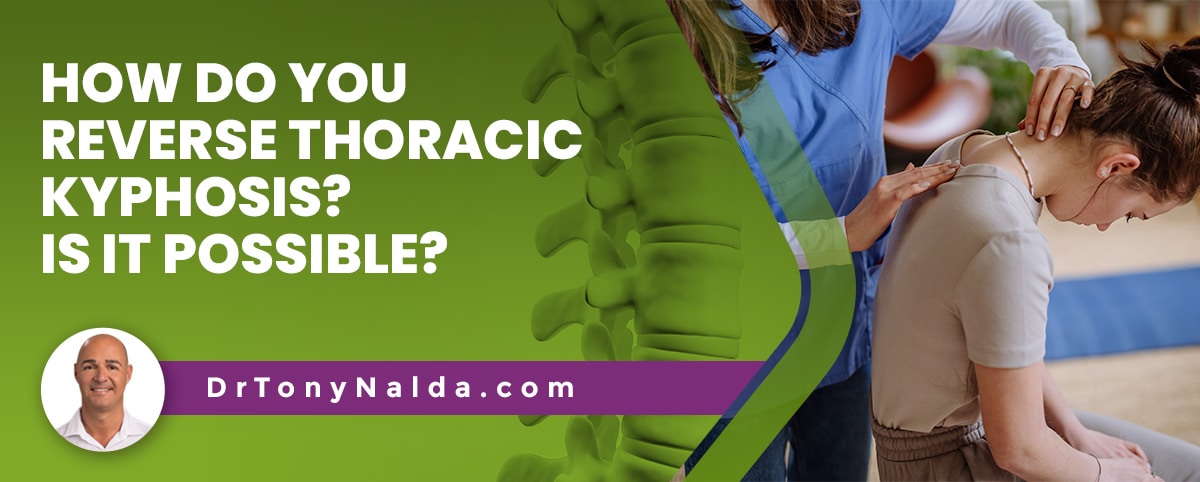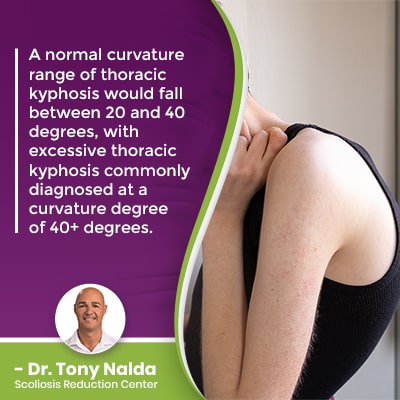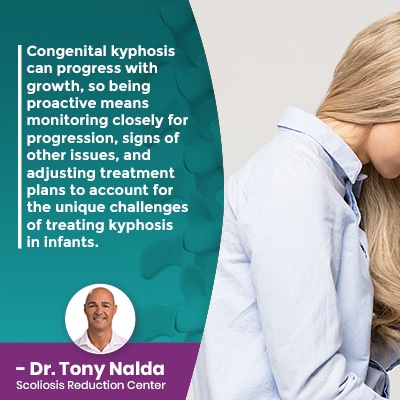How Do You Reverse Thoracic Kyphosis Is It Possible

The spine’s natural curves are key to its ability to function optimally, and there are a number of spinal conditions that involve the development of unhealthy spinal curves, thoracic kyphosis being one of them; continue reading to learn more about thoracic kyphosis and whether reversing it is possible.
A diagnosis of thoracic kyphosis means a person’s outward spinal curve in the thoracic spinal section has become excessive, causing a roundback appearance. Reversing thoracic kyphosis is possible if treated proactively and its underlying cause is addressed.
Let’s start with some basic spinal anatomy for a better understanding of how important natural spinal curves are, and what can be done about restoring them.
Table of Contents
Anatomy of a Healthy Spine
A healthy spine will appear straight if viewed from the front and/or back, and will take on a soft ‘S’ shape when viewed from either side.
In order for the spine to function optimally, it needs to have its natural and healthy curves in place, and when those curves are in place, its vertebrae are aligned in a straight and neutral position, as they should be.
The spine consists of vertebrae (bones of the spine) stacked on top of one another, and adjacent vertebrae are separated by an intervertebral disc that provides cushioning between vertebrae, structure (adjacent vertebrae attach to the disc in between), flexibility, and acts as the spine’s shock absorbers.
In fact, most cases of spinal degeneration involve the spinal discs as they are generally the first spinal structures to start to deteriorate.
When an unnatural spinal curve develops, some vertebrae (bones of the spine) are unnaturally tilted, causing the spine to become misaligned, and this can cause a number of issues related to a disruption in spinal biomechanics.
A spine that doesn’t have its natural curves in place is one that’s not as strong, flexible, or able to evenly distribute/absorb mechanical stress incurred during activity.
There are three main spinal sections, and each has its own characteristic curvature type: cervical spine (neck), thoracic spine (middle/upper back), and the lumbar spine (lower back).
The health of each spinal section and its curvature is dependent on the health of the others; when the spine develops an unnatural curve, it can respond by putting in a compensatory curve in another spinal section, and this only further disrupts the spine’s overall health, strength, and function.
Now, let’s move on to addressing the different curvature types: kyphosis and lordosis.
Kyphosis vs Lordosis
Kyphosis refers to spinal curves that bend backwards, away from the body’s center, and the spines thoracic section features a kyphotic curve.
Lordosis refers to spinal curves that bend inwards, towards the body’s center, and the cervical and lumbar spinal sections feature lordotic curves.
If a person develops excessive lordosis in the cervical or lumbar spine, it causes a swayback appearance as the buttocks and abdomen protrude excessively, and while it can affect the cervical spine, it’s more common in the lumbar spine.
Every spinal section has its unique roles to play in spinal health and function, but the lumbar spine has the added responsibility of supporting the weight of the trunk and spinal sections above.
The vertebrae of the lumbar spine also feel the effects of lifting, bending, and twisting motions.
Now, curvature sizes are measured in degrees, and while there is a natural range of curvature size, when a person’s level of kyphosis falls beyond a normal range, this is known as thoracic kyphosis and/or hyperkyphosis.
 A normal curvature range of thoracic kyphosis would fall between 20 and 40 degrees, with excessive thoracic kyphosis commonly diagnosed at a curvature degree of 40+ degrees.
A normal curvature range of thoracic kyphosis would fall between 20 and 40 degrees, with excessive thoracic kyphosis commonly diagnosed at a curvature degree of 40+ degrees.
So what happens when a person’s thoracic kyphosis falls beyond a normal range?
Symptoms of Thoracic Kyphosis
Symptoms of thoracic kyphosis are case-specific and shaped by a number of patient/condition variables: patient age, condition severity, and type.
However, some common symptoms of thoracic kyphosis include:
- Pain in the middle/upper back
- Middle/upper back stiffness
- Noticeably rounded-forward upper back and shoulder blades
- Excessive fatigue
- Issues with balance and/or coordination
- Respiratory issues (severe cases)
- Bladder/bowel issues (severe cases)
While some people can experience a number of these symptoms, others might not experience any; in general, the more severe the kyphosis is, the more likely it is that its effects will be noticeable.
As mentioned earlier, treatment plans need to be crafted around a condition’s underlying cause, and this is dependent on the type of kyphosis in question.
Kyphosis Type and Treatment Options
There are three main types of kyphosis: postural, Scheuermann’s, and congenital, and each has its own unique characteristics and treatment needs.
Postural kyphosis is caused by chronic poor posture and isn’t a structural condition, meaning it doesn’t involve a structural abnormality within the spine itself; this means that an active effort to stand up straight and pull the shoulders back can alter the nature of the curve.
Postural kyphosis is most common in adolescents who slouch, and over time, this type of posture can stretch the ligaments and muscles that support the spine, causing the vertebrae to shift out of alignment with the rest of the spine and causing the excessive kyphosis and forward-rounded appearance of the upper back and shoulders.
As a non-structural condition, postural kyphosis is the simplest to treat and can often be addressed with lifestyle guidance and physical therapy that uses specific exercises and stretches to increase the spine’s surrounding muscle strength, improve posture, and achieve a more balanced and natural body posture/position.
When it comes to Scheuermann’s kyphosis, this is a structural condition so no change in position can alter the excessive kyphotic curve.
Treatment for Scheuermann’s kyphosis will be shaped around patient age, experienced symptoms, and severity, and most often involves a combination of chiropractic care that can manually adjust the position of affected vertebrae, physical therapy to strengthen the spine’s support from surrounding muscles, corrective bracing in patients whose spines are still growing, and rehabilitation to further stabilize and heal the spine.
In cases of congenital kyphosis, babies are born with the condition as it’s caused by a malformed spine that develops in utero, and in many of these cases, there are also other issues related to malformed parts, systems, within the body.
 Congenital kyphosis can progress with growth, so being proactive means monitoring closely for progression, signs of other issues, and adjusting treatment plans to account for the unique challenges of treating kyphosis in infants.
Congenital kyphosis can progress with growth, so being proactive means monitoring closely for progression, signs of other issues, and adjusting treatment plans to account for the unique challenges of treating kyphosis in infants.
Modified treatment can include chiropractic care, physical therapy, a variety of therapies, and when appropriate, corrective bracing.
Conclusion
The spine allows us to stand upright, practice good posture, engage in flexible movement, and the spinal cord works with the brain to form the central nervous system and facilitates brain-body communication.
For someone recently diagnosed with thoracic kyphosis, it means the thoracic spine has developed an excessive kyphotic curve, making the upper back and shoulders excessively rounded.
Thoracic kyphosis is sometimes referred to as roundback after the way it changes a person’s posture and body position, and common symptoms can include back pain and stiffness, a rounded-forward appearance, difficulty standing for long periods of time, and excessive levels of fatigue.
When an unnatural spinal curve is present, it takes more energy to maintain an economical gait, and the body is constantly trying to adjust for the unnatural spinal curve.
The thoracic spine can be affected by a number of spinal conditions, as the largest spinal section contains 12 vertebral bodies (T1 to T12).
When it comes to reversing thoracic kyphosis, this means restoring a natural and healthy kyphotic curve in the thoracic spine.
I approach my thoracic kyphosis patients by customizing treatment plans to address key patient/condition variables, and the first step towards condition reversal is determining its underlying cause.
Postural kyphosis is the most common, and as a non-structural spinal condition, it’s the simplest to treat with a series of therapeutic exercises and physical therapy that can increase core strength to improve spinal support, posture, body positioning, and brain-body communication.
When it comes to Sheuermann’s kyphosis, as this is a structural condition, the curves are rigid, inflexible, and involve a structural abnormality within the spine itself, so are more complex to treat; still, reversing thoracic Scheuermann’s kyphosis is possible through combining kyphosis-specific chiropractic care, physical therapy, corrective bracing, and rehabilitation.
Cases of congenital kyphosis need to be monitored closely for signs of other abnormalities related to malformations within the body, so treatment plans need to be modified accordingly but can include gentle chiropractic care, a variety of therapies, and when appropriate, corrective bracing.
Here at the Scoliosis Reduction Center, I’ve addressed a wide range of spinal conditions successfully with non-surgical treatment, including thoracic kyphosis.
Dr. Tony Nalda
DOCTOR OF CHIROPRACTIC
After receiving an undergraduate degree in psychology and his Doctorate of Chiropractic from Life University, Dr. Nalda settled in Celebration, Florida and proceeded to build one of Central Florida’s most successful chiropractic clinics.
His experience with patients suffering from scoliosis, and the confusion and frustration they faced, led him to seek a specialty in scoliosis care. In 2006 he completed his Intensive Care Certification from CLEAR Institute, a leading scoliosis educational and certification center.
About Dr. Tony Nalda
 Ready to explore scoliosis treatment? Contact Us Now
Ready to explore scoliosis treatment? Contact Us Now





